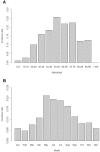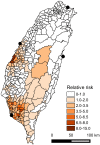Significance of major international seaports in the distribution of murine typhus in Taiwan
- PMID: 28264003
- PMCID: PMC5354449
- DOI: 10.1371/journal.pntd.0005430
Significance of major international seaports in the distribution of murine typhus in Taiwan
Erratum in
-
Correction: Significance of major international seaports in the distribution of murine typhus in Taiwan.PLoS Negl Trop Dis. 2017 May 3;11(5):e0005589. doi: 10.1371/journal.pntd.0005589. eCollection 2017 May. PLoS Negl Trop Dis. 2017. PMID: 28467406 Free PMC article.
Abstract
Background: International seaports are hotspots for disease invasion and pathogens can persist in seaports even after ports are abandoned. Transmitted by fleas infected by Rickettsia typhi, murine typhus, a largely neglected and easily misdiagnosed disease, is known to occur primarily in large seaports. However, the significance of seaports in the occurrence of murine typhus has never been validated quantitatively.
Methodology/principal findings: We studied the spatial distribution of murine typhus, a notifiable disease, in Taiwan. We investigated whether risk of infection was correlated with distance to international seaports and a collection of environmental and socioeconomic factors, using a Bayesian negative binomial conditionally autoregressive model, followed with geographically weighted regression. Seaports that are currently in use and those that operated in the 19th century for trade with China, but were later abandoned due to siltation were analyzed. A total of 476 human cases of murine typhus were reported during 2000-2014 in the main island of Taiwan, with spatial clustering in districts in southwest and central-west Taiwan. A higher incidence rate (case/population) was associated with a smaller distance to currently in-use international seaports and lower rainfall and temperature, but was uncorrelated with distance to abandoned ports. Geographically weighted regression revealed a geographic heterogeneity in the importance of distance to in-use seaports near the four international seaports of Taiwan.
Conclusions/significance: Our study suggests that murine typhus is associated with international seaports, especially for those with large trading volume. Thus, one of the costs of global trade in Taiwan might be elevated risks of murine typhus. Globalization has accelerated the spread of infectious diseases, but the burden of disease varies geographically, with regions surrounding major international seaports warranting particular surveillance.
Conflict of interest statement
The authors have declared that no competing interests exist.
Figures






References
-
- Harrison M. Contagion: how commerce has spread disease. Yale University Press; New Haven and London; 2012.
-
- Bryan CS, Moss SW, Kahn RJ. Yellow fever in the Americas. Infect Dis Clin N Am. 2004; 18: 275–292. - PubMed
Publication types
MeSH terms
Associated data
LinkOut - more resources
Full Text Sources
Other Literature Sources

